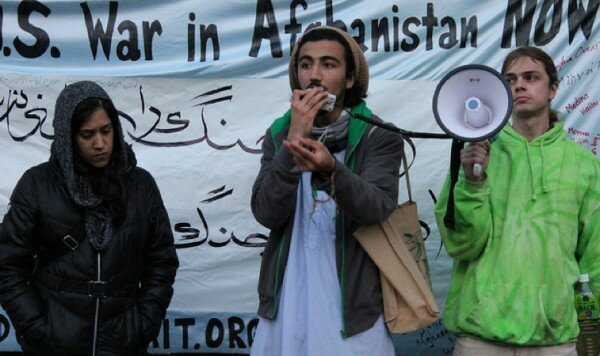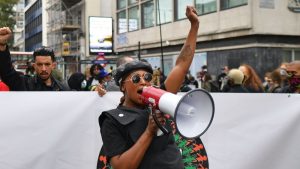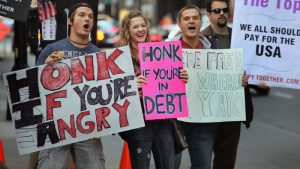
Since the beginning of Occupy Oakland six months ago, there has been little reprieve from the constant battle over principles, tactics, and structure. Unfortunately, it seems that too often what could be an illuminating debate devolves into bickering and sniping as we lose sight of our most common, though most vague, goal: making another world possible.
At an antiwar rally in Fremont, California, I witnessed a small but epiphanic moment for what the Occupy movement’s internal organization could be like. I don’t know if everyone there saw what I saw, so I would like to share what I saw and what I think that could mean for Occupy.
The rally and march were called for by two Bay Area activist groups, local chapters of Afghans for Peace and Iraq Veterans Against the War, following the massacre of seventeen Afghan civilians by an American soldier in the Panjwai district of Kandahar Province, Afghanistan. The groups shut down a Fremont, California military recruitment center to protest the War in Afghanistan and U.S. militarism around the world.
It made me wonder: what affinity do Afghan civilians have with American soldiers? Can we even imagine the damage the people from these groups have suffered because of the war and how they might blame each other for that damage, how they might consider each other enemies? What does this have to do with Occupy, and how can we learn from their example?
The origins of hate, the persistence of love
The War in Afghanistan began on October 7th, 2001–over ten years ago. Many Americans may not know that it is the longest-running U.S. military conflict, surpassing Vietnam. Since 2001, tens of thousands of Afghan civilians have been killed; estimates of just how many are rough and, beyond a shadow of a doubt, far below the actual number. In 2011 alone, there were a reported 3,021 civilian casualties.
The people of Afghanistan have seen their home ravaged by decades of Western imperialism, beginning with the dangerous game of chicken the U.S. and the Soviets imposed upon the rest of the world during the Cold War. Since then, 33 years of civil war and outside agitation, largely led by the CIA, has left millions dead and the country in shambles. It is now considered the planet’s most dangerous country, producing the most refugees and asylum-seekers in the world.
Afghanistan is also considered the 15th least developed country in the world. Many live in poverty; 35% of the country is unemployed, and 42% live on less than $1 a day. Some people seek relief by growing opium, with 90% of the world’s opium coming from Afghanistan, making these farmers vulnerable to merciless local drug lords who often have ties to the Taliban. Others feel they have no choice but to sell their children, especially girls.
The country has the highest infant mortality rate in the world, and one in ten children dies before the age of five. Average life expectancy is between 47 and 64 years. Only about 28% of Afghans are literate, with literacy rates being lower for women. As with its stunted economy, the government has also had no chance to improve its domestic policies, especially those involving women’s rights.
There can be no denying that the state of Afghanistan today is the fault of Western interference. In addition to harming social and economic progress, Western influence has a deadly real-time affect.
U.S. military and other NATO forces have repeatedly violated Afghan customs and killed civilians during operations; even President Hamid Karzai, for whom many Afghans have little respect, has made appeals to the U.S. to stop abusing and killing so many civilians. While the U.N. reports that most civilian casualties are due to insurgents, Afghans blame the increased brutality and violence on the occupying troops, and they want NATO forces out. Clashes between Taliban and NATO have driven many out of their homes, but refugees who make it out of war-torn areas are still homeless, and they still face death from malnutrition, starvation, and exposure–in February 2012, 24 children froze to death in a refugee camp in Kabul.
After over ten years of war and over 30 years of interference in Afghanistan by outside entities, which has left the country impoverished and underdeveloped, it shouldn’t surprise anyone that Afghans think of Americans as little more than another group of hostile imperialists.
Afghan hatred towards Americans is a given, and most of us probably believe it’s well within reason. It may be more difficult to understand what is behind American soldiers’ hatred of Afghans and Iraqis.
Enlisted American military recruits are usually young men between the ages of 18 and 24 and come from lower to lower-middle class households. A high percentage of military recruits are from the South and the West. Most enlistees self-identify as Caucasian, though compared to the general population, blacks are overrepresented in the armed forces.
The Department of Defense and conservatives try to convince us that young people who enlist do so because of a strong sense of patriotism–rather than out of necessity or desperation. This is demonstrably false. The number one reason young Americans join the military is to take advantage of opportunities that are not available otherwise, such as tuition for college, temporary job security, or even the promise of U.S. citizenship. In fact, as jobs have disappeared, more Americans have joined the “all-volunteer” military.
Unfortunately, it is an age-old truth that young people sent into active duty are rarely prepared for the horrors and strains of war.
After the massacre in Panjwai, the Western media reported on the possibility that the killings may spark renewed anti-American sentiments in Afghanistan. That much is obvious. But how often do we discuss the racist and anti-Afghan sentiments that American soldiers are encouraged to develop?
It’s likely that soldiers develop this hatred in order to cope. Some soldiers live in denial, forcing themselves to think of civilians as less-than-human: violent, conniving, ungrateful, and itching to murder the American troops who have come to liberate them. The secret activity of “terrorists” in occupied areas, which has left thousands of soldiers–friends and brothers in arms–dead and maimed, is supposedly evidence for this. To date, over 6,500 servicemembers have died in Afghanistan and Iraq, and many more return home with injuries both physical and psychological.
Soldiers are encouraged to harbor racism and hatred because, otherwise, they would be unable to rationalize their involvement in the war. They would have to face the harsh reality that for a chance at a better life, they’ve given their precious youth, their innocence, their mental and emotional well-being, and perhaps even their lives to the mindless killing campaign of careless, detached politicians.
Recognition of this fatal dead-end has to be devastating. Soldiers who are often suffering from PTSD or Traumatic Brain Injury (TBI) after being sent on multiple deployments may think it’s much easier to direct anger and hatred at helpless civilians rather than at the unapproachable American government, i.e. the commander-in-chief, the Department of Defense, Congress, and the hundreds of other powerful elites oiling the cogs of the unstoppable American war machine.
This is, of course, not a defense of soldiers’ unacceptable behavior but a way to understand them, as well as the staggering statistics concerning veteran psychological disorders, substance abuse, incarceration, unemployment, homelessness, failure to reintegrate into civilian society, and suicide.
There is no reason why Afghan civilians and American soldiers shouldn’t hate each other; that would be the easiest way to cope with the trauma of war. Yet, at the march in Fremont, I saw Afghan people and former American soldiers demonstrating side-by-side, making an incredible effort to understand one another, to exist together in peace, love, and solidarity.
People from these two groups come from lives filled with crushing pain and difficulty, yet they don’t see each other as enemies. In organizing this event together, they showed that they share one world, that their struggles are connected, and they are stronger fighting together than fighting apart.
There is so much we can learn from watching two groups whom it would seem could not be more disparate overcome their unbelievable differences to address American bloodlust fueled by greed.
How Occupy Oakland can deal with internal conflict
What does this teach us about the disagreements that seem too big for Occupy Oakland to grow beyond?
It teaches us that they are petty in comparison, and, furthermore, they are solvable. For months we’ve been looking outward instead of inward; now may be the time to look inward, to regroup and restructure.
Many of our conflicts appear to be between people with differing backgrounds, which is a painful thing to admit for those who consider themselves open-minded and progressive. One Occupy tweeter suggested that such disagreements may be a result of culture shock, an astute summary.* It’s difficult to bring together people from all demographics and all walks of life, and issues of racism, sexism, homophobia, and other “-isms” and “-phobias” are bound to arise.
Another Occupant and friend noted months ago that we all came to Occupy having lived within “the system” for our entire lives. “We didn’t show up to the commune, a march, a GA, or a commitee meeting, and suddenly become absolved of our ‘sins,’ ‘demons,’ and personal flaws,” she wrote in a note on Facebook.† Like it or not, we have been engrained with the ideas of the institutions we despise, and we must recognize that so we can overcome it.
This is hard to accept for people on the left whose very identities are based on empathy and tolerance, but we must recognize our prejudices as vulnerabilities, wounds that must be healed, rather than flaws that say something sinister about our characters, sins for which we must atone.
In our frenzy to develop and support actions, we’ve forgotten the importance of learning ally work and, as one friend put it, “widening perspectives.”‡ Is there not information we can share, strategies we can employ to help us understand one another? Wouldn’t it benefit us all to take the time to challenge how we manifest the dominant culture through, say, workshops and recovery groups? Or are we really proud enough to assume that we all have it figured out?
Other conflicts, such as the one between those who advocate black bloc tactics versus those who advocate nonviolent tactics, or the related conflict between those who value anonymity during acts of civil disobedience and those who support livestreaming, are purely ideological.
These disagreements are not so profound that we should let them control our dialogue or tear apart the movement we’ve built. They don’t merit any of the harassment, blacklisting, shaming, ousting, or threats of violence I’ve seen thrown around daily on Twitter and Facebook.
Often, our terrible treatment of other Occupants is based on accusations of failure to act in solidarity, but solidarity doesn’t mean that we all agree; it means that we move in concert, like individual leaves of grass moved by the wind. Each blade shivers in its unique way, but each is still pushed by the same wind. Division is natural and necessary, and we have to accept, and even appreciate, our divisions so that we can function in spite of them.
In other words, we don’t have to like each other, we don’t have to agree, we don’t even have to always work together, but we can respect each others’ vision and autonomy. The lack of faith we have in other Occupants is disappointing, but instead of trying to conform our thoughts and actions, we could try trusting each other.
It is excessively proud to believe that the loudest voices in any organization are the ones that represent all voices–that the influence that sways the Occupy Oakland GA is acting upon the desire of everyone who identifies with Occupy Oakland, which struggles to maintain quorum every week though thousands of people in the area would self-identify as 99%ers–and even Occupants.
We must acknowledge that the umbrella of Occupy has an enormous circumference, and we cannot use exclusionary tactics to alienate members of the 99%, no matter how we dislike or disagree with them.
Stirring up drama has become our modus operandi, which is good for the world but not good for the way we operate internally. We’re so accustomed to showing no mercy to the 1% that we also show no mercy to each other. This is in direct opposition to everything Occupy is supposed to be about, and we absolutely can’t survive if we go on in this fashion. We can’t create the bigger world we want to see if we can’t start within our own movement.
Looking at the members of AFP and IVAW together, I realized that disagreements within Occupy are nothing like staring into the face of a person who may have held the life of a distant family member captive at the end of a barrel, literally. If only we were all so driven by passion, dedication, and courage.
What a serious burden Occupy has taken upon itself, and what potential it has! Yet how amateur and silly we can sometimes be. People are suffering and dying because of greed, corruption, and waste, and we have in our possession the reigns to what could become one of the most powerful movements in history. We must look to the example set by AFP and IVAW two weeks ago, who, despite their differing backgrounds and goals, found a way to work together with allies from Occupy Oakland and Occupy Fremont lovingly participating. This is what all Occupy actions and events should look like.
Let’s move together.
*thanks, @mrejfox!
† thanks, @Desi_Luna!
‡ thanks, @QuestionSelf!








